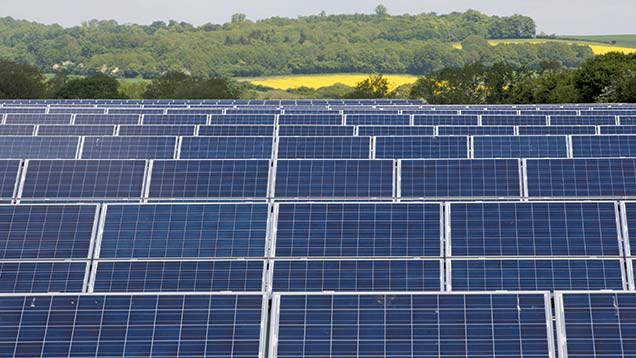Investors offer cash up front for renewable lease income
 © Tim Scrivener
© Tim Scrivener Landowners hosting large-scale renewable energy developments are the target of a new range of investors looking to access green energy income.
Several city funds have entered the market over recent months wanting to acquire the income from leases for renewable energy assets such as wind, solar and biomass projects, in exchange for a lump sum payment to the landowner.
Site requirements vary, but companies are typically focusing on large-scale projects (3-4MW upwards) producing significant rental incomes (see Typical investor requirements, below).
It is only the entitlement to the income from the lease that is being sold and not the underlying freehold of the agricultural land, explains Mark Newton of Fisher German, who says there may be the option to sell part of the project income stream and retain the remaining income.
While landowners would forego the regular long-term rental income from the developer, converting this into an upfront lump sum releases significant capital that could be used to reduce debt or invest elsewhere, such as buying more land, buildings, machinery, funding other renewable energy projects or buying property, he says.
Valuing a project
The exact value of the lump sum varies depending on the site, the risks associated with the project and inflation, so it is not a straightforward case of adding up the expected cashflow for the remaining term of the lease.
“Paying a lump sum up front today means we need to work out the net present value of the future rental income streams, in a similar way to valuing annuities,” says Joel Edington from Ingreen Capital, one of the firms offering such deals.
Income is discounted to reflect any risks associated with the rental income. Risk is affected by both site performance and factors such as whether there are break clauses in the rental agreement between the landowner and developer. The financial security of the developer would also be taken into account.
Tax advantages
Selling lease income for a lump sum could be good tax planning, Mr Newton says. Although the lump sum attracts capital gains tax at a maximum of 28%, this is potentially better than paying up to 45% income tax on the rental income, he says.
Putting the money towards buying land or running your own renewable project makes further financial sense, as after two years the capital value of the land or the project will be free of inheritance tax, whereas the capitalised rental value would attract IHT of up to 40%, he adds.
“Income from farming in-hand or running a renewable project yourself have added income tax benefits, including being able to put up to £40,000 a year into your pension free of tax, which is not available from a rental stream.”
Catherine Strickland of Thrings Solicitors advises any landowner considering selling their rental income to ensure they are clear on every detail before proceeding. This includes how much the lump sum is worth and any clawback provisions on the landowner in the event of project failure or the developer going out of business.
“It’s an interesting concept that could be useful for those with suitable projects that need to release capital, but it’s likely that you’ll be less well off in pure cash terms at the end of the day than if you’d held on to the rental income. Be clear exactly how much the lump sum is discounted and get professional advice first which considers both the legal and tax implications.”
Where land is mortgaged, it is also worth checking any plans to sell rental income with the bank, as they may not necessarily want to lose a regular income stream, she adds.
Mr Edington says there is no recourse to the landowner in the event of project failure and any other agreements between developer and landlord (such as reduced rate electricity supply, for example) will not be affected by selling the lease income.
“We’re purely acting as a financial intermediary, so all rights and obligations of the tenant and landlord remain unchanged.” The lease itself remains in the landowner’s name so any obligations such as the landowner being required to maintain the site would also continue.
Typical investor requirements
Land occupied by solar farms and wind farms:
- Solar – 20 to 200 acres, freehold or leasehold
- Wind – single or multiple sites, leasehold
- Producing a minimum £20,000 a year in rent
- Operational (near to being operational considered)
- Long leases, 20+ years
- Generating asset to be professionally operated and maintained.
Land occupied by biomass facilities:
- Freehold or leasehold
- Producing a minimum £60,000 a year in rent
- Operational (near to being operational considered)
- Long leases, 20+ years
- Generating asset to be professionally operated and maintained with long-term supply contracts.
Source: Fisher German
